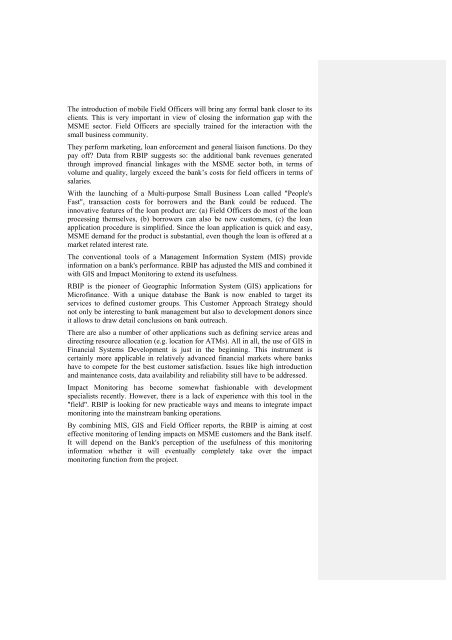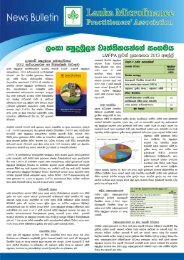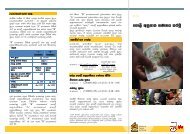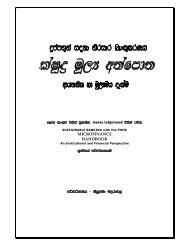National Microfinance Study of Sri Lanka: Survey of Practices and ...
National Microfinance Study of Sri Lanka: Survey of Practices and ...
National Microfinance Study of Sri Lanka: Survey of Practices and ...
Create successful ePaper yourself
Turn your PDF publications into a flip-book with our unique Google optimized e-Paper software.
The introduction <strong>of</strong> mobile Field Officers will bring any formal bank closer to its<br />
clients. This is very important in view <strong>of</strong> closing the information gap with the<br />
MSME sector. Field Officers are specially trained for the interaction with the<br />
small business community.<br />
They perform marketing, loan enforcement <strong>and</strong> general liaison functions. Do they<br />
pay <strong>of</strong>f? Data from RBIP suggests so: the additional bank revenues generated<br />
through improved financial linkages with the MSME sector both, in terms <strong>of</strong><br />
volume <strong>and</strong> quality, largely exceed the bank’s costs for field <strong>of</strong>ficers in terms <strong>of</strong><br />
salaries.<br />
With the launching <strong>of</strong> a Multi-purpose Small Business Loan called "People's<br />
Fast", transaction costs for borrowers <strong>and</strong> the Bank could be reduced. The<br />
innovative features <strong>of</strong> the loan product are: (a) Field Officers do most <strong>of</strong> the loan<br />
processing themselves, (b) borrowers can also be new customers, (c) the loan<br />
application procedure is simplified. Since the loan application is quick <strong>and</strong> easy,<br />
MSME dem<strong>and</strong> for the product is substantial, even though the loan is <strong>of</strong>fered at a<br />
market related interest rate.<br />
The conventional tools <strong>of</strong> a Management Information System (MIS) provide<br />
information on a bank's performance. RBIP has adjusted the MIS <strong>and</strong> combined it<br />
with GIS <strong>and</strong> Impact Monitoring to extend its usefulness.<br />
RBIP is the pioneer <strong>of</strong> Geographic Information System (GIS) applications for<br />
<strong>Micr<strong>of</strong>inance</strong>. With a unique database the Bank is now enabled to target its<br />
services to defined customer groups. This Customer Approach Strategy should<br />
not only be interesting to bank management but also to development donors since<br />
it allows to draw detail conclusions on bank outreach.<br />
There are also a number <strong>of</strong> other applications such as defining service areas <strong>and</strong><br />
directing resource allocation (e.g. location for ATMs). All in all, the use <strong>of</strong> GIS in<br />
Financial Systems Development is just in the beginning. This instrument is<br />
certainly more applicable in relatively advanced financial markets where banks<br />
have to compete for the best customer satisfaction. Issues like high introduction<br />
<strong>and</strong> maintenance costs, data availability <strong>and</strong> reliability still have to be addressed.<br />
Impact Monitoring has become somewhat fashionable with development<br />
specialists recently. However, there is a lack <strong>of</strong> experience with this tool in the<br />
"field". RBIP is looking for new practicable ways <strong>and</strong> means to integrate impact<br />
monitoring into the mainstream banking operations.<br />
By combining MIS, GIS <strong>and</strong> Field Officer reports, the RBIP is aiming at cost<br />
effective monitoring <strong>of</strong> lending impacts on MSME customers <strong>and</strong> the Bank itself.<br />
It will depend on the Bank's perception <strong>of</strong> the usefulness <strong>of</strong> this monitoring<br />
information whether it will eventually completely take over the impact<br />
monitoring function from the project.
















